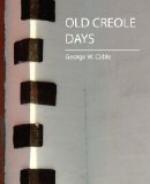An antiquated story-and-a-half Creole cottage sitting right down on the banquette, as do the Choctaw squaws who sell bay and sassafras and life-everlasting, with a high, close board-fence shutting out of view the diminutive garden on the southern side. An ancient willow droops over the roof of round tiles, and partly hides the discolored stucco, which keeps dropping off into the garden as though the old cafe was stripping for the plunge into oblivion—disrobing for its execution. I see, well up in the angle of the broad side gable, shaded by its rude awning of clapboards, as the eyes of an old dame are shaded by her wrinkled hand, the window of Pauline. Oh for the image of the maiden, were it but for one moment, leaning out of the casement to hang her mocking-bird and looking down into the garden,—where, above the barrier of old boards, I see the top of the fig-tree, the pale green clump of bananas, the tall palmetto with its jagged crown, Pauline’s own two orange-trees holding up their bands toward the window, heavy with the promises of autumn; the broad, crimson mass of the many-stemmed oleander, and the crisp boughs of the pomegranate loaded with freckled apples, and with here and there a lingering scarlet blossom.
The Cafe des Exiles, to use a figure, flowered, bore fruit, and dropped it long ago—or rather Time and Fate, like some uncursed Adam and Eve, came side by side and cut away its clusters, as we sever the golden burden of the banana from its stem; then, like a banana which has borne its fruit, it was razed to the ground and made way for a newer, brighter growth. I believe it would set every tooth on edge should I go by there now,—now that I have heard the story,—and see the old site covered by the “Shoo-fly Coffee-house.” Pleasanter far to close my eyes and call to view the unpretentious portals of the old cafe, with her children—for such those exiles seem to me—dragging their rocking-chairs out, and sitting in their wonted group under the long, out-reaching eaves which shaded the banquette of the Rue Burgundy.
It was in 1835 that the Cafe des Exiles was, as one might say, in full blossom. Old M. D’Hemecourt, father of Pauline and host of the cafe, himself a refugee from San Domingo, was the cause—at least the human cause—of its opening. As its white-curtained, glazed doors expanded, emitting a little puff of his own cigarette smoke, it was like the bursting of catalpa blossoms, and the exiles came like bees, pushing into the tiny room to sip its rich variety of tropical sirups, its lemonades, its orangeades, its orgeats, its barley-waters, and its outlandish wines, while they talked of dear home—that is to say, of Barbadoes, of Martinique, of San Domingo, and of Cuba.
There were Pedro and Benigno, and Fernandez and Francisco, and Benito. Benito was a tall, swarthy man, with immense gray moustachios, and hair as harsh as tropical grass and gray as ashes. When he could spare his cigarette from his lips, he would tell you in a cavernous voice, and with a wrinkled smile that he was “a-t-thorty-seveng.”




